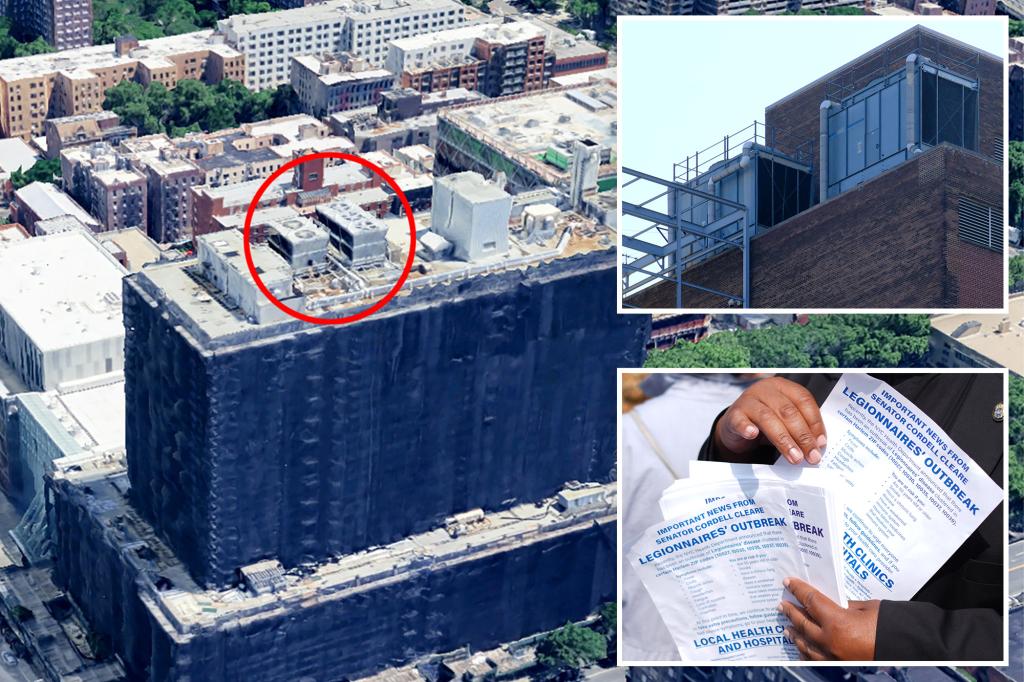Rainwater left untreated in cooling towers atop city-owned Harlem Hospital fueled the Big Apple’s deadliest Legionnaire’s disease outbreak in a decade, the Rev. Al Sharpton charged Tuesday.
Sharpton, along with civil rights attorney Ben Crump, plan to unveil a lawsuit Wednesday against a construction company that did work in Harlem – the epicenter of an outbreak that has killed five people and sickened more than 100.
“People should be able to depend on our hospitals and public spaces,” Sharpton told The Post.
“We clearly should be monitoring this more closely. We have to be diligent about it. We cannot allow this Legionnaires’ outbreak to be normalized.”
Cooling towers at Harlem Hospital filled with rainwater after several large July storms, but was left untreated — permitting the bacteria to spread among workers at the site, according to statement from Sharpton and Crump.
The lawsuit, while still-murky, dovetails with growing suspicions that the city dropped the ball on inspections of cooling towers at its buildings — including Harlem Hospital — and others that helped incubate the insidious bacteria that causes Legionnaires’ disease.
Four of 12 cooling towers that tested positive for Legionella bacteria were on city- or government-owned buildings.
Two of those buildings — Harlem Hospital and the city Department of Health’s Central Harlem Sexual Health Clinic — are on the same stretch of West 137th Street, a quiet residential neighborhood.
Building owners by state law and city health code are required to test for the disease-causing bacteria Legionella every 90 days to avoid outbreaks.
City health department scientists also separately conduct inspections, usually every year, on cooling towers to make sure they’re adequately disinfected and building owners are regularly testing for Legionella.
A Post analysis of city records showed the Central Harlem Sexual Health Clinic had racked up 18 violations during cooling tower inspections starting in 2017.
No city record showed whether the clinic’s cooling tower had been tested for Legionella.
A DOH spokesperson said a new tower had been installed on the building in June.
“Just four weeks ago, the cooling tower on top of the clinic tested negative for Legionella bacteria,” the spokesperson said in a statement.
“The water sample taken in July 2025 as part of the Legionnaires’ Disease Cluster response was positive, showing how quickly Legionella bacteria can grow in cooling towers.”
The spokesperson didn’t immediately have information on whether the previous tank had been tested for Legionella, or why it was replaced.
The first positive diagnoses of Legionnaires’ in the recent outbreak were made July 22, according to DOH data.
But Daniel Mckeithan, a 52-year-old chef, said he first felt sick on June 19 when he headed to his daughter’s baby shower in Atlanta.
Believing it to be the flu, Mckeithan spent the baby shower in a hotel before coming back to New York. He went to Harlem Hospital on June 23, where doctors observed him as antibiotics were administered by IV for the better part of a week.
“I was scared. It affects your lungs. I still feel a pull on lungs,” he said.
“Legionnaires’ hits you — and it hits you real fast.”
Mckeithan said it was “actually crazy” to hear that the hospital he was being treated at — and where he returns for follow-up appointments — had a cooling tower that tested positive for Legionella.
“You’re talking about a government building,” he said.
“They should be minding their Ps and Qs.”
Jory Lange — an attorney representing 44 Legionnaires’ patients in the current outbreak, including Mckeithan and one who died — already has a pending lawsuit against the city’s Health + Hospitals alleging a cooling tower at Harlem Hospital caused a 2021 outbreak.
He called it “very disturbing” that a third of the cooling towers in the recent outbreak were government-owned.
“Who knows how long the cooling towers were positive?” he said.
Attorney Scott A. Harford, who is co-counsel in the pending suit and repped 15 plaintiffs sickened during a 2018 outbreak in Washington Heights’ Sugar Hill, said the Legionella bacteria will explode in “no time,” if building owners don’t have a water management plan.
“It’s concerning that there are so many city-owned entities that are having issues maintaining their water, and that requires an examination of their water quality plan, who they’re using and how they’re maintaining their water,” he said.
Robert, a 59-year-old who stepped out of a pizza shop across from the Harlem clinic, called the city “irresponsible.”
“It’s a city run hospital goddamn it,” he said.
“I don’t believe in coincidences. I don’t believe that this could not have been prevented. It’s only happening in Harlem.”
Toya M., who lives directly across the street from the clinic, wasn’t surprised by the outbreak.
“We are always forgotten,” Toya said. “Had this been a white neighborhood, they would’ve been inspected regularly.
“Harlem is always last on the list for everything, obviously.”
Mayor Eric Adams, during an unrelated event Tuesday, defended the city’s health department. He argued Legionnaires’-causing bacteria can pop up shortly after a negative test.
“I don’t think anyone could accuse the Department of Health and Mental Hygiene of not really being proactive and reactive, when it comes out to saving the lives of New Yorkers,” he said.
— Additional reporting by Craig McCarthy and Vaughn Golden
Read the full article here

